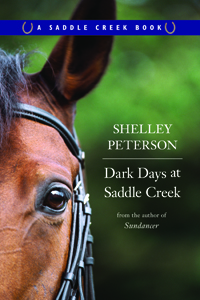| ________________
CM . . . . Volume XVIII Number 31 . . . . April 13, 2012
excerpt:
Dark Days at Saddle Creek is Shelley Peterson’s third novel about Bird, a girl who can speak telepathically with animals. Animal and human characters from Sundancer and Mystery at Saddle Creek return in Dark Days at Saddle Creek, as well as characters from Peterson’s previous trilogy about Abbey Malone and the horse Dancer, but Dark Days at Saddle Creek is complete in itself and can be read without the others. Bird, short for Alberta, rides the horse Sundancer and competes in jumping and derby events. She stays with her aunt, Hannah, at Saddle Creek farm and helps with the horses and the younger riders. When a riding acquaintance, Sally, comes to her in the middle of the night saying her horse is about to be taken away, Bird decides to rescue Tall Sox by bringing him back to Saddle Creek. Thus begins a complicated plot involving trainer Dexter Pill and an insurance fraud scam. Dexter deliberately injures horses and convinces their owners to sell them or put them down. With the help of her animal friends, Bird is able to hide Tall Sox from Dexter until the undercover agent Frank Skelton can arrest Dexter and his accomplices. Bird discovers that Frank can also speak telepathically, and she wonders if he is her father. He denies his paternity at first, but, in the end, she finds out he is her father. He will not jeopardize his undercover work in order to be a proper father, and Bird has to reconcile herself to his absence. There are more complicated family dynamics at play that will be familiar to readers of the previous novels: Bird has an uncomfortable relationship with her mother, and she has a grandfather whom she helped get arrested and who wants revenge. Because there is also the death of an older character who has played a role in all six of Peterson’s books, this book has a fairly serious tone.
Recommended. Kim Aippersbach is a freelance editor and writer with three children in Vancouver, BC.
To comment
on this title or this review, send mail to cm@umanitoba.ca.
Copyright © the Manitoba Library Association. Reproduction for personal
use is permitted only if this copyright notice is maintained. Any
other reproduction is prohibited without permission.
NEXT REVIEW |
TABLE OF CONTENTS FOR THIS ISSUE
- April 13, 2012.
AUTHORS |
TITLES |
MEDIA REVIEWS |
PROFILES |
BACK ISSUES |
SEARCH |
CMARCHIVE |
HOME |
||||||
